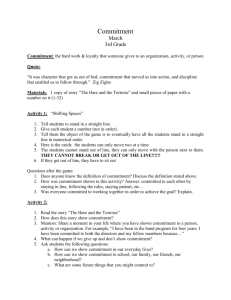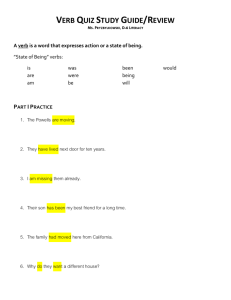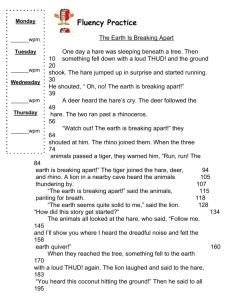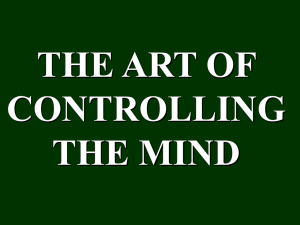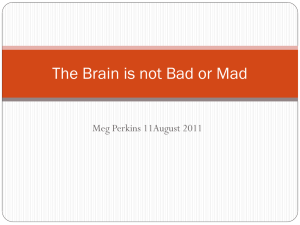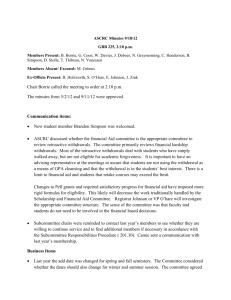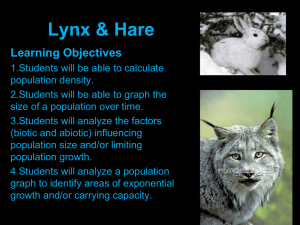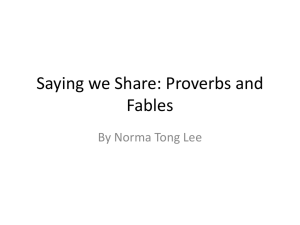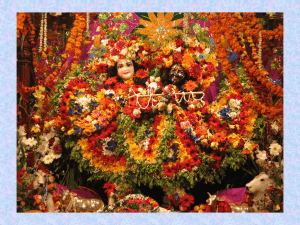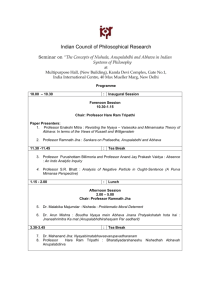Flexibility in Hare Social Organization.
advertisement
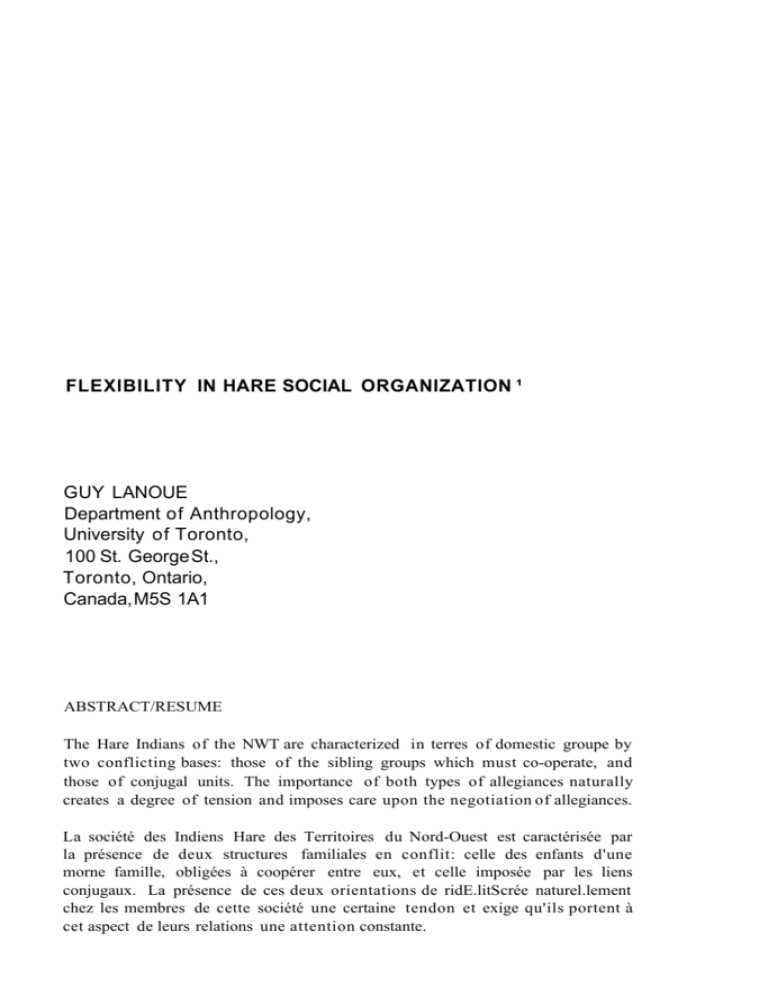
FLEXlBILITY IN HARE SOCIAL ORGANIZATION ¹ GUY LANOUE Department of Anthropology, University of Toronto, 100 St. George St., Toronto, Ontario, Canada, M5S 1A1 ABSTRACT/RESUME The Hare Indians of the NWT are characterized in terres of domestic groupe by two conflicting bases: those of the sibling groups which must co-operate, and those of conjugal units. The importance of both types of allegiances naturally creates a degree of tension and imposes care upon the negotiation of allegiances. La société des Indiens Hare des Territoires du Nord-Ouest est caractérisée par la présence de deux structures familiales en conflit: celle des enfants d'une morne famille, obligées à coopérer entre eux, et celle imposée par les liens conjugaux. La présence de ces deux orientations de ridE.litScrée naturel.lement chez les membres de cette société une certaine tendon et exige qu'ils portent à cet aspect de leurs relations une attention constante. 260 GUY LANOUE INTRODUCTION One striking feature of the anthropological descriptions of Athabascan Indian bands with bilateral, bifurcate-merging kinship terminology is the apparent lack of definite structurally-produced ru.les which might serve to provide an orientation for an individual's social action (cf. Helm 1956:131; Savashinsky 1974:xv, 194). The flexibility and negotiability of social relationships that usually appear to be associated with such systems are hot seen as positive features resulting from tendencies produced by structural regularities but rather are characterized as being the product of an absence of well defined sociologial reference points for the individual actor. This "definition by absence" does not appear to provide any useful insights into Athabascan social structure, as anthropological observers readily adroit that this negotiable feature of social relationships varies with the type of kin involved in the bilaterally-defined universe (cf. Savashinsky 1970:48,49). Furthermore the widespread practice of adoption and the assumption of 'kin' terres and attitudes by genealgically unrelated persons also brings into question the utility of the bilateral and kinship concepts. It may point to the fact that the terminology may have nothing especially to do with kinship, defined as simple biological ties between people; adoption may not indicate that there is a "real" relationship opposed to it. Thirdly, the undoubted survival of patterned regularities in the terminological system through various phases of Euro-Canadian contact points to its possible importance in ordering certain aspects of Indian social life. Helm, for example, arques that the socio-territorial units of the Hare Indians range from task groups to local band to regional hand to tribe, with the size and duration of the group being the distinguishing criteria (Helm 1965:380). "One joins a task group: one is born into, and ordinarily rennains a member of, the tribe." (Ibid:381). The hypothesis that is advanced in this paper is that the negotiation off allegiances to social groups of various size and duration is necessarily a feature that is associated with the fact of being affiliated with a certain social group that bas a previous history of allegiances. This previous history of allegiances results in tension HARE SOCIAL ORGANIZATION 261 for the negotiation of present and future allegiances. This structurally-generated tension is actively manifested in many dimensions of social life and may serve as a point of entry for the understandingand explanation of many current politicaland social issues of the Hare. The extension of Euro-Canadianinvolvementin the North, particularly since World War II, is well known and needs no documentation. It is also common knowledge that many recent events have been accompanied by a phenomenal growth in the quantity and quality of vocal expression by many Euro-Canadian and Indian organizations and associations whose main activity can best be described as political. This activity provides a meeting ground for discussion of issues that affect both participants. But it remains problematical whether or not this debate carries the same message to all participants. Certainly, if there exist positive structural features associated with the kinship system that serve to provide well defined points of orientation to the social actor, then it is likely that these structural features provide in some measure an ideological orientation as well that would filter all messages sent and received in political debate and world view. Localizingthe problem. Fort Good Hope has a population of approximately350 natives and 50 Euro-Canadians.It is located 60 miles South of the Arctic Circle on the Mackenzie River. Colville Lake is 110 miles to the Northwest. Both settlements contain Hare Indians in the majority. Both were the site of major studies by Savashinsky,Sue and Helm. Both are important because, a) alone of all Athabaskan Indian groups they have a registered hunting territory with free access to all residents of the towns. Land use rights are vested in the community and no registeredtraplines or family hunting territoriesexist, or are believed to exist, b) The operation of the kinship system - its knowledge and use - reflects the categorizationof the social world performed by the Hare. In addition, production networks and constituted social groups appear to overlap with so-called 'kin' groups such as the domestic group and male patronymic groupings. At Fort Good Hope, "....the employment of Iroquoian cousin 262 GUY LANOUE terminology was unequivocal among the Hare....where informants displayed more knowledgeand consistencein kin terminologythat I have ever encountered before" (Helm 1960:279). If the kinship system still operates, the reasons for this occurance could provide insight into general economic processes and the fur trade in particular, where apparently similar economic factors are not so obviously correlated with continued use of traditionalnative forms of social categorization , c) Contact and trade with the Hare has been continual and direct at this locationsince at least 1836 (Savashinsky 1974:46). The effect of contact on problemsof land use and occupation has therefore been continual and concurrent to other issues in which the Hare are involved. It is possible that given the apparent continued operation of the 'kinship' system in social relations, then problems of contact have in some measure been resolved by the Hare. The fur trade factor should thus be controllablein analysis. Developmentof the Problem. Early unresolved conflicts in data and explanation of the kinship nomenclature of Athabaskan Groups can be traced back to Spier who in 1925 established his Mackenzie Basin Type, w h e r e / / o r Xcousins were not distinguished from siblings in the terminology. 2 This was apparently in response to diverse opinions about the problem of classification of kinship systems by cousin terms, originally proposed by Morgan (1871). Spier (1925:69-88) places the Hare into the "Iroquois Type" because unlike other Athabaskan groups who merge cousin and sibling terms, the Hare distinguish //-cousin/nephew-niece terms from X-cousin/nephew-niece terms. Helm reports that her Hare informants preserve these cross/parallel distinctions (1960:283-286). Similar distinctions are made on the 0 generation level, with//-cousin/cousins receiving sibling terms and X-cousinsaddressedby separate terms. If we assume for a moment that the Hare follow genealogical convention, there are inconsistenciesin the data. In a bilateral, bifurcate-merging system such as the Hare are alleged to possess a certain equivalence in terms of reference can be expected at any given equidistant genealogical point. We would expect that BS/BD (m.s.) = ZS/ZD (f.s.). But in the Hare relationship terms recorded by Sue (1964:408-409), which are consistent with Helm's partial list HARE SOCIAL ORGANIZATION 263 (1960:280-281),we find that BS (m.s.) /= ZS (f.s.) while BD (m.s.) = ZD (f.s.). Similarly, the expected equation ZS/ZD (m.s.) = BS/BD (f.s.) in practice yields: ZS (m.s.) /= B.S. (f.s.) and ZD (ms.) /= BD (f.s.). Even if the relationship of sex of the speaker to sex of the designatedkin is not taken into account, then the expected equation BS/BD = ZS/ZD (m.s.) yields : BS :4 ZS (m.s.) and BD # ZD (m.s.). BS/BD = ZS/ZD (f.s.) yields : BS /= ZS (f.s.) and BD # ZD (f.s.). Even odder is that BS (m.s.) and BD (f.s.) share the same term, while ZD (m.s.) /= ZS (f.s.). Clearly, these sets of terms indicate that the Hare relationship terms do not form a simple bilateral, bifurcate-merging pattern. On the other hand, males and females refer to S and D by the same respective terms, as would be expected in a genealogicallybased system. Also S/D = ZS/ZD (f.s.) but S/D /= BS/BD (m.s.). Rather, D = ZD (m.s.) while S /= ZS (m.s.). These distinctions are not based on genealogical distance. On the second ascending generation level we find that FF/FM (m.s.) = FF/FM (f.s.), which is genealogically correct, but on the second descendinggenerationlevel we find that SS/SD, DS/DD (ms.) /= SS/SD, DS/DD (f.s.). There is some merging by a male/female pair on the 2A generation level that is not present on the 2D level. This again suggests that the pattern formed by the Hare relationship terms is not a bilateral, bifurcate-mergingone. A second interpretation of the Hare data is suggested by Helm, who argues that despite a fairly uniform application of bifurcatemerging terminology, bifurcate-collateral classification is found on the 1A generation level (f.s.) and on the ID generation level for S's collateral relatives (m.s.) (Helm 1960:287). Helm's data then suggest that a unilineal tendency is present and that X-cousin marriage was possibly practiced. Murdock evolves three correlative determinants of bifurcate-merging terminology (Murdock 1949:141 185): 1) unilineal descent groups, 2) certain forms of X-cousin marriage and 3) matri-or partrilocal residence after marriage. Taking the last of Murdock's paradigm first, the Hare data do not indicate any definite rules of residence after marriage (Helm 1960: 287). There has been a noted tendency towards temporary matrilocality in the fulfillment of bride service which does not appear to be the case today. In any event a settlementof 350 people would have 264 GUYLANOUE allowed the fulfillment of such duties without necessitating an actual change in location of the domestic group. Perhaps even more significant is the evidence that older, long established domestic groups tend to break up once its offspring find spouses, so that F often comes to llve with S and SWi and M with D and DHu. If anything, the Hare have a "generationally-reversed bilocality", if residence is taken in its usual meaning, i.e., long term living arrangements. Secondly, the bifurcate-mergingcharacteristics(with unilineal tendencies) could be consistent with X-cousin marriage. If patrilocal residence were the rule, as Driver and Mass,ey contend (1957: 401-402), contested by Helm (1960:287), and if inheritance of important land use rights were matrilineal,then and only then would X-cousin marriage appear as an attempted solution to the problem of divergence between inheritance of hunting rights and the practice of hunting (following Levi Strauss 1967:1-47). But these conditions are not met by the Hare. In addition, no areas of [and appear restricted to certain groups. There are no clearly demarcated family hunting territories, nor does it appear likely that bounded areas would appear within a group that does not have obvious exclusive sub-groups such as clans, sibs or moieties but rather has inclusive groupings such as the domestic group, which merges male and female patronymic identities (the reverse of clan-based conjugal groupings). Thirdly, there is no evidence of unilinealityin reckoningkinship or accession to any important rights, duties and obligations. Hare informants cannot trace "lines of relationship" (Helm 1960:292). Helm's conclusion must therefore be disputed on the weight of the data, some of which she herself raises. Her conclusion, however, does elicit a concern with the fur trade factor in the social history of the Hare since she concludes that the evidence of Xcousin marriage, scant as it is, reveals an "....incompletely developed response to demographic and economic demands of the fur trade" (ibid:291-292), a response which apparently diffused from contact with other Athabaskan groups. This response may be the product of the extraordinary suseptibility of Athabaskan groups to extraneous influences (ibid:292). Several obvious issues come to mind: 1) since the aboriginal social structure is completely unknow, especially since the Hare HARE SOCIAL ORGANIZATION 265 were involved in the fur trade long before White contact occurred (through Chipewyan intermediaries), then there is no basis for comparison that allows a developmental bias such as "response" to be concluded; 2) the fur trade did not appear to have changed Hare usage of land. Although there is no direct evidence, certain evidence from other Athabaskan groups suggests that at least two responses to the fur trade were 'economic' rather than 'social'. Three strategies were open to the Indians; when fur prices were low, participation in the money economy declined and participationin the traditional economy increased (cf. Asch 1976:2). Another strategy was the product of early trade conditions where an Indian could obtain goods through trading meat rather than furs (Asch 1977:49): 3) my own research into Hudson Bay Company records for Northern B.C. reveals that when debt became too high as a result of poor fur prices, the Sekani trappers would trade at another Hudson Bay Company post. Apparently accounting control was loose enough to permit the playing of one post against another, causing the cancellation of excessive debts in order to lure the Sekani back to "their" trading posts in the interests of inventory regulation. Social arrangements and land use patterns thus could remain relatively intact, although I have not ascertained if this situation obtained for the Hare as well. It certainly could be a common practice among all Indian groups not occupyingthe middleman position. One factor which may have prevented the occurrence of competition (and hence social change) among Indians regardless of the items involved in trade was the valuation placed by Indians on the European goods. The fur trade involved only luxury items while items that Indians came to consider necessitiessuch as iron implements were often given away as gratuities by the Bay (Asch 1976:2). G i ven that there is no evidence to suggest that the Hare ever evolved anything but the present system of free access to land and resources to all band members then the combination of the aforementioned factors must have been sufficient to minimize the impact of the fur trade on the social structural aspects of the relationship terms. 4) There is no reason to believe that the fur trade, with at least two or three distinguishable phases, each based on a different mode of defining the value of products, would have elicited an "incomplete response" in one phase that was consistent with another phase (cf. Asch 1977:47-55). In other words, the 266 GUYLANOUE response to one phase would not necessarilybe consistent with the conditions of a subsequent period. If it is argued that this response is a recent phenomenon, then it becomes difficult to reconcile this with the continued strong participation of Athabaskan Indians in the native hunting economy when fur prices have been at a low point since the second World War (cf. Berger 1977: i 10-11 l; Asch 1976:7; Asch n.d.:7). Given the unlikelypresence of X-cousin marriage then it would appear plausible that Hare relationshipterms are not associatedwith any repeated alliances between discrete exclusive groups. Dumont has argued that similarities in alliance histories of kin produce similarities in the application of relationship terms in the taxonomically similar Dravidian kinship system (1953:35-36). An allied conclusion emerges from my consideration of Hare relationship terms: that generational differences produce differences in view of the kinship universe.However, the lack of patterned alliances would indicate that the Hare view of "kinship" will be dissimilar from the Dravidian. One possible factor in producing this difference appears to be marital status; a male/femalesibling pair applies similarterms to the 2A generationlevel yet it is a male/femaleconjugalpair which 'sees' the 2D generation level differently (see diagrams 1,2,7 and 8). A convergence results when 'looking up'; divergence when 'looking down' (cf. Turner 1976:106-124). This broad conclusion is consistent with Turner's (1976) and Dunning's (1959) arguments that production arrangementscan be fluid yet of primary importance when structuring relationship terms and subsequent alliances. Dunning, for example, suggests that trapping partners from a co-residential unit (ibid:105) will maintain continued economic cooperation within this unit (ibid:57). This unit usually consists of people who consider each other to be kin, either a man and his brothers and their families, or a man and married sons' families (ibid:58). Kinsmen are partnersin production while non-kin (X-cousins and their collaterals and affines) are preferred marriage partners (ibid:72-73). Turner has also argued that shared production tasks are primary in the formation of " k i n " networks and " k i n " groups among the Cree (1976:75-94). Hare relationship terms apparently reflect a dynamic process of dual allegiance similar to that which Turner identified for the Cree (ibid: 106-124). HARE SOCIAL ORGANIZATION 267 If this similar situation exists for the Hare two obvious characteristics of the taxonomic pattern exhibited by their relationship terms can be hypothetically explained: i) a male and female ego's view of the kinship system vary dependent on 'looking up' or 'looking down' (see diagrams 1,2,7 and 8). Men and women would tend to see the past as a compendiumof jointly realizedproduction arrangement.s. The potentials were realized on the 1A generation level and persist even when a sibling pair set up respectiveconjugal arrangements. When looking down as members of conjugal groups their views differ, reflecting the possibility of future potential arrangements. 2) A male/female ego's view of the kinship system differs when 'looking across' (see diagrams 3,5 and 6). Different views of actual and potential production/kinship arrangements could be dependent and whether membership in a male/female sibling pair or conjugalpair is stressed.The Hare usage of patronymic identification of domestic groups and conjugal pairs reflects this dual perspective. During late adolescence and early adulthood (recognized by the Hare as the class eke for males and Christian names for females (Hurlbert 1962:47), men and women work for a domestic group of origin as a sibling pair and later work for a domestic group of marriage. Women especially, it would seem, switch their labour allegiance more dramatically than men by surrenderingtheir patronymic identity upon marriage and adopting the husband's (personal observation, see also Savashinsky 1974: 223fn, 227-228fn, for a discussion of "family" names). Men tend to retain associationsbased on a common patronymicwhich usually originates within a shared domestic group. The Hare of Colville Lake, for example, have I0 of 14 domestic groups sharing only three patronymics: Patronymic A: 4 brothers 1 stepson of one of the brothers 1 son of one of the brothers Patronymic B: 2 brothers Patronymic C: 1 father 1 son Ten of 14 households share primary patrilineal ties (Savashinsky 1970:41). All of these sometimes camp and cooperate with one 268 GUY LANOUE another, although not exclusively (ibid:41). The identification or closeness between brothers is also found among sisters. The closest bonds are between same sexed siblings (Savashinsky 1974:68). Thus the formation of kinship/production arrangements is a developmental process that starts with membership in a domestic group of origin, continues based on the closeness of same-sexed siblings and is supplemented by the formation of conjugally-based associations. Male ego differentiates between children of F/m's same sexed siblings, and children of F/M's opposite sexed sibling are addressed by ego by the same terms used to address ego's siblings5 which is a reflection of the special closeness between F and FB and M and MZ. Children of ego's F/M's opposite sexed siblings are addressed by separate terms because they are apparently not associatedwith F/M through an especially close sibling bond. For a married male ego, ZHu is not as close as B because the link to Z is not as close as the link to B. WiB is also not as close to ego as B because the link to WiB is through a qualitatively different type of closeness. WiB and ZHu are consideredas close as MBS and FZS, again because MB and FZ are not close to F/M. One significant characteristicof male and female view of their own generation mates points to a process of classificationthat is based on conjugal links of the present generation rather than sibling links on the 1A generation; that is, how males view BWi and WiZ and how females view ZHu and HuB. Both males and females use term 20 (see Appendix l) to address these people. A male categorizes FZD and MBD differently than WiZ and BWi, implyinga different conception of his relationshipof 'closeness'to these people. Nor do females categorize ZHu and HuB in the same class as MBS and FZS. From the male point of view, B is a favouredsiblingand WiZ is Wi's favoured sibling. A special category is created by the Hu/Wi tie that is apparently independent of the processes of allegiance which occurred on the 1A generation level. From the female viewpoint, HuB is recognized as being close to Hu and ZHu is close to ego by virtue of Z's relationship to ego. Similarly she calls HuBWi by a term which the Hare translate into English as "friend", while male ego calls WiZHu by the same term. There would thus appear to be dual identitiesthat are available HARE SOCIAL ORGANIZATION 269 to the Hare as factors that can be used to moderate negotiable relationships: the fact of being a member of a domestic group of origin, which emphasizes sibling identity, and the fact of being a party to conjugal ties, which emphasizes conjugal identity. One factor which may be linked to this is that ego's sibling identity is invoked in recognizingspecial ties with MZD (f.s.) and FBS (ms.) while in fact F/M's conjugal situation on the i A generation corresponds to ego's own on the 0 generation;that is, FB and MZ are addressed by term 20 by M and F respectively as are their spouses, ego's FBWi (F speaking) and MZHu (M speaking). Both of these conjugal units produce siblings for a male/femalesiblingego. If this hypothesis is correct, then the result of these dual views would be that relationships formed through the conjugal link of a man or woman tend to displace ties formed as a result of shared sibling identities as the conjugal units becomes more economically autonomous through time. Yet the strength of this conjugal union lies precisely in the ability of the two spouses to negotiate and exploit relationships based on their respective sibling identities. A/so, the special conjugal categories of Wit, WiZHu and BWi (m.s.) and HuB, HUBwi and ZHu (f.s.) involve people with the conjugal group who have their own sibling and conjugally-based relationships. The feelings of generosity that a man feels towards his siblings Within a domestic group would lessen considerably with the development of his conjugal ties. The 'strength' of the conjugalgroup could become such that it accounts for the tendency of older people to be drawn away from their group and into their offspring'sgroup; a repudiation of their sibling/conjugal ties. An elderly man is often supported by S and SWi while FWi (m.s.) is often supported by and liveswith her D and DHu. In contradistinction to the economic autonomy developed within a domestic group over time, one fact illustrates the dichotomous position of conjugal groups. There exists a strong ethic urging generosity (Savashinsky 1970:45-51). For example, people are expected to be particularlygenerous with moose kills while caribou, being the more abundant, are not usually shared between families (ibid:47). Savashinsky notes the environmentalcause of generosity, arguing that it relievesenvironmentally based stress caused by scarcity (ibid:46). Yet I would argue that moose and caribou are interchangeableas food values, at 270 GUY LANOUE least as far as the Hare are concerned,so t h a t the emphasiso n sharing moose which is a scarce c o m m o d i t y , a n d ' h e r d i n g ' caribou, which isn't, is in fact a p r o d u c t of social stress r a t h e r then environmental stress. Moose is only socially scarce since no household goes hungry without it as caribou is easily substituted as a food value. Rather the presentation of the socially scarce gift between families points to an ideological a t t e m p t to obfuscate the problem of the nature of household a u t o n o m y . The gift could be a re-affirmationof sibling ties at the expense o f conjugal ties, or vice-versa, but it carries the same ambiguous message in either case: 1) m y household exists because of you, hut, 2) this gift re-affirms our domestic existence as it is the product of joint domestic labour. The fact that moose are unpredictableas game, while caribou are not, could also be a factor in the moose/cariboudifferentiation. The sharing of moose under these conditions m a y indicate the ascendanceo f one domestic group over others on a t e m p o r a r y basis, or rather an a t t e m p t to ideologically obfuscate that ascendance. The message contained in this interpretation of the gift of moose meat is different than the first, yet still strongly interrelated it m a y indicate an a t t e m p t to re-affirm ties with o t h e r domestic groups when the luck of one domestic group threatens to make it economically quasiindependent. I would argue that m a n y behavioural characteristicso f Hare social life can be related to the simultaneous a u t o n o m o u s / d i c h o t o m o u s structural position o f households in relation to other households. For example, given the above context, it is understandable why the Euro-Canadiansystem o f inheritance o f p a t r o n y m i c s was a d o p t e d b y the Hare; it meshes well with the different des a man has with his Wi and F/B and the ties a w o m a n has with H u and M/Z. We can also expect a tendency for 2 brothers to marry 2 sisters (evident in Savashinsky's observations 1970:59,41), a n d / o r a t e n d e n c y towards the levitate a n d sororate (evident in Helm's observations 1960:288-289). We would expect parents to express a strong concern with their offspring'schoice of spouse (Savashinsky 1974:196-198, 207, 227-228). All these factors can be associated with the continued strength o f conjugalties at the expense of sibling identity within a domestic g r o u p a continual process of affirmation and denial. A n d we would expect t h a t the world view t h a t integrated the HARE SOCIAL ORGANIZATION 271 Hare o n a more abstract level could be an attempted solution to the problem o f a u t o n o m y / d i c h o t o m y yet , it would be a solution that is as impossible as is a totally a u t o n o m o u s household. Conclusion There are 2 identified perspectives within Hare cultural life, both poised for systematic coherence yet neither of which are realized as the encompassing and enduring framework for interpreting social relations. Taken simultaneously both perspectives engage a contradiction but this simultaneityis never realized b y an individual as it would engage a p a r a d o x which would preclude all social action. However, the contradictionis realized by participants to an interchange or b y an individual at different stages of his/her life. A n y interpretation o f Hare social flexibility, and probably all other A t h a b a s k a n groups, should therefore be based on the realization that w h a t is a p p a r e n t l y unsystematic on the level of the participant, i.e., any behaviour observed by the anthropologist, is systematic on the deeper historical level, where structural principles unfold not in the abstract but in the historical course of alliances. NOTES 1. I am deeply indebted to D.H. Turner, R. MacDonnell,S. Nagata and H. Lawrence for their suggestions and criticisms of an earlier draft of this paper. 2. Abbreviationsused: H: parallel X; cross M: mother F: father B: brother Z: sister D: daughter S son Hu: husband Wi: wife m.s.: male speaking f.s.: female speaking 3. The Hare use terms of address and terms of reference, where the reference form usually consists of the address term plus a prefix. 272 GUY LANOUE REFERENCES Arch, Michael 1976 The Impact of Changing Fur Trade Practices On the Economy of the Slavey Indians: Some Preliminary Conclusions Regarding the Period: 1870 - 1900, paper delivered at Canadian Ethnological Society symposium on Early Mercantile Enterprises;Winnipeg. 1977 nd. The Dene Economy;in Dene Nation . the colony within, ed. by M. Watkins, University of Toronto Press, Toronto. Statement in Response to Dr. C. Hobarr's Testimony: SocioEconomic Overview of the Mackenzie River Corridor; unpublished paper, Edmonton. Berger, T.R. 1977 Northern Frontier, Northern Homeland: The Report of the Mackenzie Valley Pipeline Inquiry Vol. 1, Minister of Supply and Services Canada, Ottawa. Driver, H.E. and W.C. Massey 1957 Comparative Studies of North American Indians, Transaction of the American Philosophical Society 47:165.456, Philadelphia. Dumont, L. 1953 The Dravidian Kinship Terminology as an Expression of Marriage; Man 53:34-39. Dunning, R.W. 1959 Social and Economic Change among the Northern Ojibwa; University of Toronto Press, Toronto. Helm MacNeish, June 1956 Leadership Among the Northeastern Athabascans, Anthropologica 2:31-59. 1960 Kin Terms of the Arctic Drainage Dene: Hare, Slavey, Chipewyan, American Anthropologist 62:279-295. Helm, June 1965 Bilaterality in the Socio-Territorial Organization of the Arctic Drainage Dene, Ethnology 4:361-385. Hurlbert, Janice 1962 Age as a factor in the social organization of the Hare Indians of Fort Good Hope, N.W.T.; Department of Northern Affairs and National Resources, Ottawa. HARE SOCIAL ORGANIZATION 273 Levi-Strauss, Claude 1967 The Story of Asdiwal; in The Structural Study of Myth and Totemism, ed. by E. Leach, Tavistock, London. Mason, J.A. 1946 Notes on the Indians of the Great Slave Lake Area;Yale University Publications in Anthropology no. 34, Yale University Press, New Haven. Morgan, L.H. 1871 Systems of Consanguinity and Affinity of the human family: Smithsonian Contributions to Knowledge 17:291-382. Murdock, G.P. 1949 Social Structure; MacMillan Co., New York. Richardson, Sir John 1851 Arctic Searching Expedition: A Journal of a Boat-Voyage Through Rupert's Land and the Arctic Sea, in search of the Discovery Ships under Command of Sir John Franklin;2 vols., Longman, Brown, Green and Longmans, London. Savashinsky, J. 1970 Kinship and the Expression of Values in an Athabascan Bush Community; WesternCanadianJournal of Anthropology2:51-59. 1974 Spier,L. 1925 Sue, H, 1965 The Trailof the Hare;Cordon and Breach,NewYork. The distributionof Kinshipsystems in North America;University of Washington Publications in Anthropology 1:69 88. Hare Indians and their World; unpublished Ph.D. thesis, Bryn Mawr College. Turner, D. 1976 Shamattawa:the structureof socialrelationsin a Northern Algonkianband;NationalMuseumof Man,Ottawa. Wentzel, W.F. 1889-90 "Letters to the Hon. Roderic Mackenzie",1807-1824, in L.F.R. Masson, Les Bourgeois de la Compagnie du Nord-Ouest, serie 1, Quebec. 274 GUY LANOUE APPENDIX I: HARE KINSHIP TERMS Number Reference Address I e'si e'si 2 3 4 5 6 7 8 9 a'so se ene sa at/In se ira sa apa sara sedewe sanoge se'be sotie sesile a'so ene ama one apa ata sedewe anoge e'be otie sile 10 sa'tare a'tare 11 set'e set'e 12 sela 13 14 15 16 English (1) Genealogical Content (2) grandfather grandchildren grannie mother FM, FM"Z", MM, MM"Z" M(m.s.), Wi in address(m.s.) father F(f.s.), Hu in address(f.s.) F"B ", M"B" M" B",F"Z"Hu M"Z",F"B""WI" F"Z", M" B"Wi OlB, OlF"B"S, OlM"Z"S YoB, F"B"YoS, M"Z"Yos, "B"S(f.s.) sela uncle uncle aunt aunt elder B younger B cousin nephew older Z cousin younger Z cousin cousin setse yune setzekwe setiele seige setseyune setzekwe tiele seige cousin wife sweetheart co usin 17 18 19 20 sedenece sedeneli se ek'e sanai sedenece sedene ek'e banal 21 22 23 24 seya sepa setue sesa seya sepa setue sesa 25 sefwi se fwi 26 27 seyeto seiege seyeto seiege cousin husband sweatheart B-in-law Z-in-law S, nephew nephew D, niece nephew niece D-in-law grandchildren niece D-in-law S-in-law friend 3A FF,FF"B", MF, MF"B", " C h " ( m . s . ) OlZ, F"B"OlD, M"Z"OlD YoZ, F"B"YoD. M"Z"YoD F"Z"S(m.s.), M"B"S(m.s.), "Z"Hu (m.s.), Wl"B"(m.s.) F"Z"D(m.s.), M"B"D(m.s.) Wi(m.s.) sweetheart (m s.) (3) F"Z"D(f.s.), M"B"D(f.s.) "B"Wi(f.s.), Hu"Z"(f.s.) F"Z"S(f.s.), M"B"S(f.s.) Hu(f.s.) sweetheart (f.s.) (3) "B"Wi(m.s.), Wi"Z"(m.s.), "Z"Hu(f.s.), Hu"B"(f.s.) S, "Z"S(f.s.) "Z"S(m.s.) D, "B"D(m.s.), "Z"D(f.s.) "B"S(m.s.), "B"D(f.s.), "S"Wi(f.s.), "Ch"Ch "Z"D(m.s.), SWi DHu Wi"Z"Hu(m.s.). Hu"B"Wi(f.s.) (1) The English versions were recorded by Sue from Haze informant. (2) The genealogical positions are as they appear in Sue's thesis, including the quotation marks around certain individuals and links. They are taken to mean: not necessarily genealogical position. (3) Sue's own description. Presumably no genealogical connection was established. HARE SOCIAL ORGANIZATION Diagram no. 1 : Female ego 'looking down.' Diagram no. 2: Male ego 'looking down'. Diagram n o 3: Female 'looking across'. Diagram no. 4: Male/female conjugal pair 'looking across'. Diagram no. 5 : Male/female ego sibling pair 'looking across'. 275 275 GUY LANOUE Diagram no. 6: Male ego 'looking across'. Diagram no. 7: Male/female sibling pair 'looking up'. Diagram no. 8: Male female sibling pair 'looking up'.
